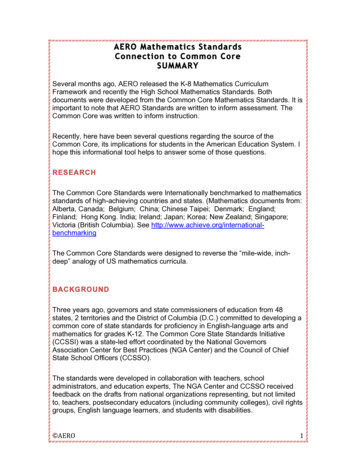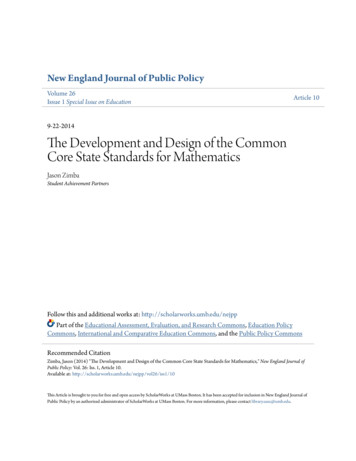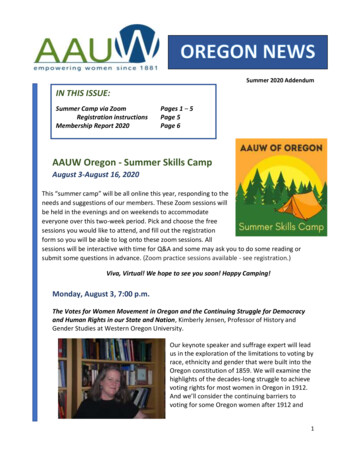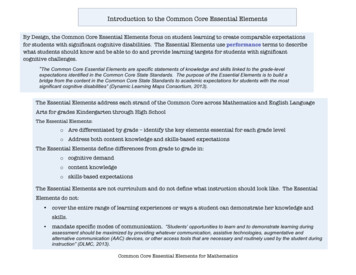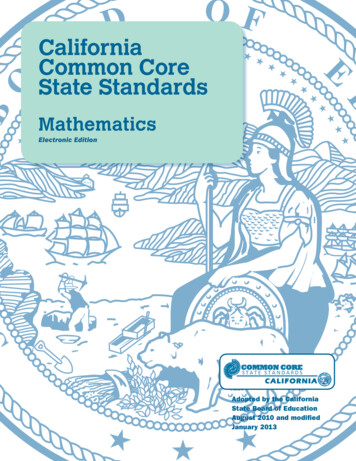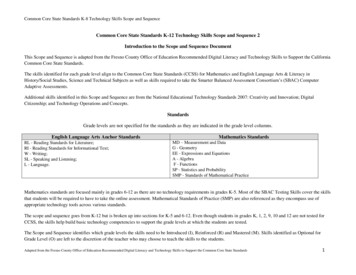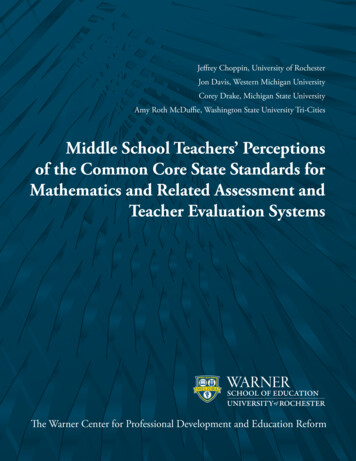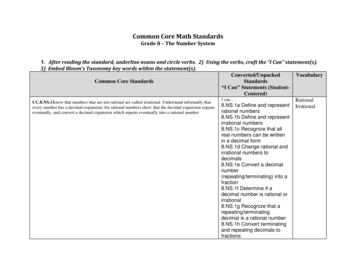
Transcription
COMMONCORE State StandardsDECONSTRUCTED forCLASSROOM IMPACT3THIRD GRADE ARTSMATHEMATICS855.809.7018 www.commoncoreinstitute.com
MATHEMATICSIntroductionThe Common Core Institute is pleased to offer this grade-level tool for educators who are teaching with theCommon Core State Standards.The Common Core Standards Deconstructed for Classroom Impact is designed for educators by educatorsas a two-pronged resource and tool 1) to help educators increase their depth of understanding of theCommon Core Standards and 2) to enable teachers to plan College & Career Ready curriculum andclassroom instruction that promotes inquiry and higher levels of cognitive demand.What we have done is not all new. This work is a purposeful and thoughtful compilation of preexistingmaterials in the public domain, state department of education websites, and original work by the Centerfor College & Career Readiness. Among the works that have been compiled and/or referenced are thefollowing: Common Core State Standards for Mathematics and the Appendix from the Common Core StateStandards Initiative; Learning Progressions from The University of Arizona’s Institute for Mathematics andEducation, chaired by Dr. William McCallum; the Arizona Academic Content Standards; the North CarolinaInstructional Support Tools; and numerous math practitioners currently in the classroom.We hope you will find the concentrated and consolidated resource of value in your own planning. We alsohope you will use this resource to facilitate discussion with your colleagues and, perhaps, as a lever to helpassess targeted professional learning opportunities.Understanding the OrganizationThe Overview acts as a quick-reference table of contentsas it shows you each of the domains and related clusterscovered in this specific grade-level booklet. This can helpserve as a reminder of what clusters are part of whichdomains and can reinforce the specific domains for eachgrade level.Key Changes identifies what has been moved to andwhat has been moved from this particular grade level,as appropriate. This section also includes CriticalAreas of Focus, which is designed to help you begin toapproach how to examine your curriculum, resources,and instructional practices. A review of the Critical Areasof Focus might enable you to target specific areas ofprofessional learning to refresh, as needed.Math Fluency StandardsKAdd/subtract within 51Add/subtract within 102Add/subtract within 203Multiply/divide within 1004Add/subtract within 1,000,0005Multi-digit multiplication6Multi-digit division7Solve8Solve simple 2 x 2 systems by inspectionFor each domain is the domain itself and the associatedclusters. Within each domain are sections for each of the associated clusters. The cluster-specific contentcan take you to a deeper level of understanding. Perhaps most importantly, we include here the LearningProgressions. The Learning Progressions provide context for the current domain and its relatedstandards. For any grade except Kindergarten, you will see the domain-specific standards for the currentCOMMON CORE STATE STANDARDS DECONSTRUCTED FOR CLASSROOM IMPACT3
THIRD GRADELEXILE GRADE LEVEL BAND: 520L TO 820Lgrade in the center column. To the left are the domain-specific standards for the preceding grade and to theright are the domain-specific standards for the following grade. Combined with the Critical Areas of Focus,these Learning Progressions can assist you in focusing your planning.For each cluster, we have included four key sections: Description, Big Idea, Academic Vocabulary, andDeconstructed Standard.The cluster Description offers clarifying information, but also points to the Big Idea that can help you focuson that which is most important for this cluster within this domain. The Academic Vocabulary is derivedfrom the cluster description and serves to remind you of potential challenges or barriers for your students.Each standard specific to that cluster has been deconstructed. There Deconstructed Standard for eachstandard specific to that cluster and each Deconstructed Standard has its own subsections, which canprovide you with additional guidance and insight as you plan. Note the deconstruction drills down to thesub-standards when appropriate. These subsections are: Standard Statement Standard Description Essential Question(s) Mathematical Practice(s) DOK Range Target for Learning and Assessment Learning Expectations Explanations and ExamplesAs noted, first are the Standard Statement and Standard Description, which are followed by the EssentialQuestion(s) and the associated Mathematical Practices. The Essential Question(s) amplify the Big Idea,with the intent of taking you to a deeper level of understanding; they may also provide additional contextfor the Academic Vocabulary.The DOK Range Target for Learning and Assessment remind you of the targeted level of cognitivedemand. The Learning Expectations correlate to the DOK and express the student learning targets forstudent proficiency for KNOW, THINK, and DO, as appropriate. In some instances, there may be no learningtargets for student proficiency for one or more of KNOW, THINK or DO. The learning targets are expressionsof the deconstruction of the Standard as well as the alignment of the DOK with appropriate consideration ofthe Essential Questions.The last subsection of the Deconstructed Standard includes Explanations and Examples. This subsectionmight be quite lengthy as it can include additional context for the standard itself as well as examples ofwhat student work and student learning could look like. Explanations and Examples may offer ideas forinstructional practice and lesson plans.4COMMON CORE STATE STANDARDS DECONSTRUCTED FOR CLASSROOM IMPACT
OVERVIEWMATHEMATICSStandards for Mathematical Practice in 3rd GradeEach of the explanations below articulates some of the knowledge and skills expected ofstudents to demonstrate grade-level mathematical proficiency.PRACTICEEXPLANATIONMake sense andpersevere in problemsolving.Students know that doing mathematics involves solving problems anddiscussing how they solved them. Students explain to themselves themeaning of a problem and look for ways to solve it; they may use concreteobjects or pictures to help them conceptualize and solve problems. Itbecomes more routine for students to check their thinking by askingthemselves, “Does this make sense?” Students listen to other students’strategies and are able to make connections between various methods fora given problem.Reason abstractly andquantitatively.Students recognize that a number represents a specific quantity;they connect the quantity to written symbols and can create a logicalrepresentation of the problem at hand, considering both the appropriateunits involved and the meaning of quantities.Construct viablearguments and critiquethe reasoning of others.Students may construct arguments using concrete referents, suchas objects, pictures, and drawings. They refine their mathematicalcommunication skills in discussion the teacher facilities by askingquestions such as “How did you get that?” and “Why is that true?”. Theyexplain their thinking to others and respond to others’ thinking.Model with mathematics.Students experiment with representing problem situations in multipleways including numbers, words (mathematical language), and graphicalrepresentations. Students have extensive opportunities to generatevarious mathematical representations and to solve both equationsand story problems; they are able to explain connections betweenrepresentations as well as between representations and equations.Students are able to evaluate their results in the context of the situationand reflect on whether the results make sense.Use appropriate toolsstrategically.Students consider the available tools (including estimation) when solvinga problem and decide when certain tools might be helpful.Attend to precision.Students develop their mathematical communication skills; they try touse clear and precise language in their discussions with others and in theirown reasoning. They are careful about specifying units of measure andstate the meaning of the symbols they choose.Look for and make use ofstructure.Students look closely to discover a pattern or structure, such ascommutative and distributive properties.Look for and expressregularity in repeatedreasoning.Students begin to look for regularity in problem structures when solvingmathematical tasks. Further, students use repeated reasoning whilesolving a task with multiple correct answers.Look for an expressregularity in repeatedreasoning.Students should notice repetitive actions in computation and look formore shortcut methods, recognizing, for instance, how to apply thecommutative and distributive properties.COMMON CORE STATE STANDARDS DECONSTRUCTED FOR CLASSROOM IMPACT5
THIRD GRADELEXILE GRADE LEVEL BAND: 520L TO 820LOVERVIEWOperations and Algebraic Thinking (OA) Represent and solve problems involving multiplication and division. Understand properties of multiplication and the relationship between multiplication and division. Multiply and divide within 100. Solve problems involving the four operations, and identify and explain patterns in arithmetic.Number and Operations in Base Ten (NBT) Use place value understanding and properties of operations to perform multi-digit arithmetic.Number and Operations – Fractions (NF) Develop understanding of fractions as numbers.Measurement and Data (MD) Solve problems involving measurement and estimation of intervals of time, liquid volumes, and masses ofobjects. Represent and interpret data. Geometric measurement: understand concepts of area and relate area to multiplication and to addition. Geometric measurement: recognize perimeter as an attribute of plane figures and distinguish betweenlinear and area measures.Geometry (G) Reason with shapes and their attributes.Mathematical Practices (MP)MB 1. Make sense of problems and persevere in solving them.MB 2. Reason abstractly and quantitatively.MB 3. Construct viable arguments and critique the reasoning of others.MB 4. Model with mathematics.MB 5. Use appropriate tools strategically.MB 6. Attend to precision.MB 7. Look for and make use of structure.MB 8. Look for and express regularity in repeated reasoning.6COMMON CORE STATE STANDARDS DECONSTRUCTED FOR CLASSROOM IMPACT
OVERVIEWMATHEMATICSKEY CHANGESNEW TOTHIRD GRADEMOVED FROMTHIRD GRADE Area and perimeter (3.MD.5, 3.MD.6, 3.MD.7) Permutation and combinations (4.02, 4.03) Rectangular Coordinate System (3.02) Circle graphs (4.01)KEY CHANGES1. Developing understanding of addition, subtraction, and strategies for addition andsubtraction within 100. Students develop an understanding of the meanings of multiplication and division of wholenumbers through activities and problems involving equal-sized groups, arrays, and area models;multiplication is finding an unknown product, and division is finding an unknown factor in thesesituations. For equal-sized group situations, division can require finding the unknown number ofgroups or the unknown group size. Students use properties of operations to calculate productsof whole numbers, using increasingly sophisticated strategies based on these properties to solvemultiplication and division problems involving single-digit factors. By comparing a variety ofsolution strategies, students learn the relationship between multiplication and division.2. Developing understanding of fractions, especially unit fractions (fractions with numerator1).CRITICAL AREASOF FOCUS Students develop an understanding of fractions, beginning with unit fractions. Students viewfractions in general as being built out of unit fractions, and they use fractions along with visualfraction models to represent parts of a whole. Students understand that the size of a fractionalpart is relative to the size of the whole. For example, 1/2 of the paint in a small bucket could be lesspaint than 1/3 of the paint in a larger bucket, but 1/3 of a ribbon is longer than 1/5 of the sameribbon because when the ribbon is divided into 3 equal parts, the parts are longer than when theribbon is divided into 5 equal parts. Students are able to use fractions to represent numbers equalto, less than, and greater than one. They solve problems that involve comparing fractions by usingvisual fraction models and strategies based on noticing equal numerators or denominators.3. Developing understanding of the structure of rectangular arrays and of area. Students recognize area as an attribute of two-dimensional regions. They measure the area of ashape by finding the total number of same size units of area required to cover the shape withoutgaps or overlaps, a square with sides of unit length being the standard unit for measuring area.Students understand that rectangular arrays can be decomposed into identical rows or intoidentical columns. By decomposing rectangles into rectangular arrays of squares, students connectarea to multiplication, and justify using multiplication to determine the area of a rectangle.4. Describing and analyzing two-dimensional shapes. Students describe, analyze, and compare properties of two-dimensional shapes. They compare andclassify shapes by their sides and angles, and connect these with definitions of shapes. Studentsalso relate their fraction work to geometry by expressing the area of part of a shape as a unitfraction of the whole.COMMON CORE STATE STANDARDS DECONSTRUCTED FOR CLASSROOM IMPACT7
THIRD GRADELEXILE GRADE LEVEL BAND: 520L TO 820L8COMMON CORE STATE STANDARDS DECONSTRUCTED FOR CLASSROOM IMPACT
DOMAIN:OPERATIONS ANDALGEBRAIC THINKING(OA)THIRD GRADEMATHEMATICS
MATHEMATICSCLUSTERSOperations and Algebraic Thinking (OA)1. Represent and solve problems involving multiplication and division.2. Understand properties of multiplication and the relationship between multiplication anddivision.3. Multiply and divide within 100.4. Solve problems involving the four operations, and identify and explain patterns in arithmetic.OPERATIONS AND ALGEBRAIC THINKING (OA)SECONDTHIRDFOURTHEarly Equations and ExpressionsSection 1: Exploring arithmetic and geometricpatterns/sequencesSection 1: Exploring arithmetic and geometricpatterns/sequences3.OA.9 Identify arithmetic patterns (includingpatterns in the addition table or multiplicationtable), and explain them using properties ofoperations.Section 2: Exploring EquationsSection 2: Exploring EquationsSection 1: Exploring arithmetic and geometricpatterns/sequences4.OA.5 Generate a number or shape pattern thatfollows a given rule. Identify apparent features ofthe pattern that were not explicit in the rule itself.Section 2: Exploring Equations3.OA.4 Determine the unknown whole numberin a multiplication or division equation relatingthree whole numbers.3.OA.8 Solve two-step word problems using thefour operations (restricted to whole numbers)and apply rules for order of operations. Representthese problems using equations with a letterstanding for the unknown quantity. Assessthe reasonableness of answers using mentalcomputation and estimation strategies includingrounding.Multiplication and DivisionSection 1: Understanding and RelatingMultiplication and Division OperationsSection 1: Understanding and RelatingMultiplication and Division OperationsSection 1: Understanding and RelatingMultiplication and Division Operations2.OA.3 Determine whether a group of objects (upto 20) has an odd or even number of members,e.g., by pairing objects or counting them by 2s;write an equation to express an even number as asum of two equal addends.1.OA.1 Interpret products of whole numbers, e.g.,interpret 5 7 as the total number of objects in 5groups of 7 objects each. For example, describe acontext in which a total number of objects can beexpressed as 5 7.4.OA.1 Interpret a multiplication equation asa comparison, e.g., interpret 35 5 7 as astatement that 35 is 5 times as many as 7 and 7times as many as 5. Represent verbal statementsof multiplicative comparisons as multiplicationequations.3.OA.2 Interpret whole-number quotients ofwhole numbers, e.g., interpret 56 8 as thenumber of objects in each share when 56 objectsare partitioned equally into 8 shares, or as anumber of shares when 56 objects are partitionedinto equal shares of 8 objects each.4.OA.2 Multiply or divide to solve word problemsinvolving multiplicative comparison, e.g., byusing drawings and equations with a symbol forthe unknown number to represent the problem,distinguishing multiplicative comparison fromadditive comparison.3.OA.3 Use multiplication and division within100 to solve word problems in situationsinvolving equal groups, arrays, and measurementquantities, e.g., by using drawings and equationswith a symbol for the unknown number torepresent the problem.OA.6 Understand division as an unknown-factorproblem.COMMON CORE STATE STANDARDS DECONSTRUCTED FOR CLASSROOM IMPACT11OPERATIONS & ALGEBRAIC THINKINGDOMAIN
THIRD GRADELEXILE GRADE LEVEL BAND: 520L TO 820LOPERATIONS AND ALGEBRAIC THINKING (OA)SECONDTHIRDFOURTHSection 2: Multiplication and Division Propertiesand FactsSection 2: Multiplication and Division Propertiesand FactsSection 2: Multiplication and Division Propertiesand Facts3.OA.5 Apply properties of operations asstrategies to multiply and divide. Examples: If 6 4 24 is known, then 4 6 24 is also known(commutative property of multiplication). 3 5 2can be found by 3 5 15, then 15 2 30, or by5 2 10, then 3 10 30 (associative propertyof multiplication). Knowing that 8 5 40 and 8 2 16, one can find 8 7 as 8 (5 2) (8 5) (8 2) 40 16 56 (distributive property).3.OA.7 Fluently multiply and divide within 100,using strategies such as the relationship betweenmultiplication and division (e.g., knowing that 8 5 40, one knows 40 5 8) or properties ofoperations. By the end of Third Grade, know frommemory all products of two one-digit numbers.Section 3: Factors and MultiplesSection 3: Factors and MultiplesSection 3: Factors and Multiples4.OA.4 Find all factor pairs for a whole number inthe range 1 - 100. Recognize that a whole numberis a multiple of each of its factors. Determinewhether a given whole number in the range1 - 100 is a multiple of a given one-digit number.Determine whether a given whole number in therange 1 - 100 is prime or composite.Students distinguish the terms “factors” and“multiples” in multiplication.4.NBT.5 Multiply a whole number of up to fourdigits by a one-digit whole number, and multiplytwo two-digit numbers, using strategies basedon place value and the properties of operations.Illustrate and explain the calculation by usingequations, rectangular arrays, and/or area models.4.NBT.6 Find whole-number quotients andremainders with up to four-digit dividends andone-digit divisors, using strategies based on placevalue, the properties of operations, and/or therelationship between multiplication and division.Illustrate and explain the calculation by usingequations, rectangular arrays, and/or area models.4.OA.3 Solve multistep word problems posedwith whole numbers and having wholenumber answers using the four operations,including problems in which remainders mustbe interpreted. Represent these problems usingequations with a letter standing for the unknownquantity. Assess the reasonableness of answersusing mental computation and estimationstrategies including rounding.Section 5: Multiplication and Division ProblemsInvolving Non-Whole Rational Number Operators(Fractions)Section 5: Multiplication and Division ProblemsInvolving Non-Whole Rational Number Operators(Fractions)Section 5: Multiplication and Division ProblemsInvolving Non-Whole Rational Number Operators(Fractions)NF.4.a Understand a fraction a/b as a multiple of 1/b.4.NF.4.b Understand a multiple of a/b as amultiple of 1/b, and use this understanding tomultiply a fraction by a whole number.NF.4.c Solve word problems involvingmultiplication of a fraction by a whole number,e.g., by using visual fraction models andequations to represent the problem.Source: turnonccmath.net, NC State University College of Education12COMMON CORE STATE STANDARDS DECONSTRUCTED FOR CLASSROOM IMPACT
MATHEMATICS1. Represent and solve problems involving multiplication and division.Students develop strategies for adding and subtracting whole numbers based on their prior work withsmall numbers. They use a variety of models, including discrete objects and length-based models (e.g.,cubes connected to form lengths), to model add-to, take-from, put-together, take-apart, and comparesituations to develop meaning for the operations of addition and subtraction, and to develop strategiesto solve arithmetic problems with these operations.An important component of solving problems involving addition and subtraction is the ability torecognize that any given group of objects (up to 10) can be separated into sub groups in multiple waysand remain equivalent in amount to the original group (e.g., A set of 6 cubes can be separated into a setof 2 cubes and a set of 4 cubes and remain 6 total cubes).BIG IDEA:ACADEMICVOCABULARY:Multiplication and division are related operationsproducts, groups of, quotients, partitioned equally, multiplication, division, equal groups, group size,arrays, equations, unknownSTANDARD AND DECONSTRUCTIONInterpret products of whole numbers, e.g., interpret 5 x 7 asthe total number of objects in 5 groups of 7 objects each. For3.OA.1 example, describe a context in which a total number of objectscan be expressed as 5 x 7.DESCRIPTIONThis standard interprets products of whole numbers.PROBLEM TYPE: COMPAREESSENTIALQUESTION(S) FORTHE STANDARDMATHEMATICALPRACTICE(S)DOK Range Targetfor Instruction &AssessmentInstructional TargetsInstructional TargetsStudents shouldbe able to:Difference Unknown:Bigger Unknown:Jim purchased 5 packages of muffins. Each package contained 3muffins. How many muffins did Jim purchase? 5 groups of 3, 5 x 3 15. Describe another situation where there would be 5 groups of3 or 5 x 3.Sonya earns 7 a week pulling weeds. After 5weeks of work, how much has Sonya worked?Write an equation and find the answer.Describe another situation that would match7x5.How can I find the total number of objects in equal groups?3.MP.1. Make sense of problems and persevere in solving them.3.MP.4. Model with mathematics.3.MP.7. Look for and make use of structure.T1T2o3o4Know: Concepts/SkillsThinkDoTasks assessing concepts, skills and proceduresTasks assessing expressing mathematical reasoningTasks assessing modeling applicationsFind the product of multiple groupsof objects.Interpret products of wholenumbers as a total number ofobjects in a number of groups.COMMON CORE STATE STANDARDS DECONSTRUCTED FOR CLASSROOM IMPACT13OPERATIONS & ALGEBRAIC THINKINGCLUSTER :
THIRD GRADELEXILE GRADE LEVEL BAND: 520L TO 820LEXPLANATIONSAND EXAMPLESStudents recognize multiplication as a means to determine the total number of objects when there are aspecific number of groups with the same number of objects in each group. Multiplication requires students tothink in terms of groups of things rather than individual things. Students learn that the multiplication symbol ‘x’means “groups of” and problems such as 5 x 7 refer to 5 groups of 7.To further develop this understanding, students interpret a problem situation requiring multiplication usingpictures, objects, words, numbers, and equations. Then, given a multiplication expression (e.g., 5 x 6) studentsinterpret the expression using a multiplication context (see Table 2). They should begin to use the terms“factor” and “product” as they describe multiplication.Students may use interactive whiteboards to create digital models.14COMMON CORE STATE STANDARDS DECONSTRUCTED FOR CLASSROOM IMPACT
MATHEMATICSInterpret whole-number quotients of whole numbers, e.g.interpret 56 8 as the number of objects in each share when 56objects are partitioned equally into 8 shares, or as a number of3.OA.2 shares when 56 objects are partitioned into equal shares of 8objects each. For example, describe a context in which a numberof shares or a number of groups can be expressed as 56 8.DESCRIPTIONThis standard focuses on two distinct models of division: partition models and measurement (repeatedsubtraction) models.Partition models provide students with a total number and the number of groups. These models focus onthe question, “How many objects are in each group so that the groups are equal?” A context for partitionmodels would be: There are 12 cookies on the counter. If you are sharing the cookies equally among threebags, how many cookies will go in each bag?Measurement (repeated subtraction) models provide students with a total number and the number ofobjects in each group. These models focus on the question, “How many equal groups can you make?” Acontext for measurement models would be: There are 12 cookies on the counter. If you put 3 cookies ineach bag, how many bags will you fill?ESSENTIALQUESTION(S) FORTHE STANDARDMATHEMATICALPRACTICE(S)DOK Range Targetfor Instruction &AssessmentInstructional TargetsInstructional TargetsStudents shouldbe able to:When you divide what do you find?3.MP.1. Make sense of problems and persevere in solving them.3.MP.4. Model with mathematics.3.MP.7. Look for and make use of structure.T1T2o3o4Know: Concepts/SkillsThinkDoTasks assessing concepts, skills and proceduresTasks assessing expressing mathematical reasoningTasks assessing modeling applicationsKnow what the numbers in adivision problem represent.Explain what division means andhow it relates to equal sharesInterpret quotients as the numberof shares or the number of groupswhen a set of objects is dividedequally.EXPLANATIONSAND EXAMPLESStudents recognize the operation of division in two different types of situations. One situation requiresdetermining how many groups and the other situation requires sharing (determining how many in eachgroup). Students should be exposed to appropriate terminology (quotient, dividend, divisor, and factor).To develop this understanding, students interpret a problem situation requiring division using pictures,objects, words, numbers, and equations. Given a division expression (e.g., 24 6) students interpret theexpression in contexts that require both interpretations of division (see Table 2).Students may use interactive whiteboards to create digital models.COMMON CORE STATE STANDARDS DECONSTRUCTED FOR CLASSROOM IMPACT15OPERATIONS & ALGEBRAIC THINKINGSTANDARD AND DECONSTRUCTION
THIRD GRADELEXILE GRADE LEVEL BAND: 520L TO 820LSTANDARD AND DECONSTRUCTIONUse multiplication and division within 100 to solve wordproblems in situations involving equal groups, arrays, and3.OA.3 measurement quantities, e.g., by using drawings and equationswith a symbol for the unknown number to represent theproblem.DESCRIPTIONThis standard references various problem solving context and strategies that students are expectedto use while solving word problems involving multiplication & division. Students should use a varietyof representations for creating and solving one-step word problems, such as: If you divide 4 packs of 9brownies among 6 people, how many cookies does each person receive? (4 x 9 36, 36 6 6).The glossary (see Table 2, page 89; the table is included at the end of this document for your reference)gives examples of a variety of problem solving contexts in which students need to find the product, thegroup size, or the number of groups. Students should be given ample experiences to explore all of thedifferent problem structures.Examples of multiplication: There are 24 desks in the classroom. If the teacher puts 6 desks in each row,how many rows are there? This task can be solved by drawing an array by putting 6 desks in each row. Thisis an array model.This task can also be solved by drawing pictures of equal groups; 4 groups of 6 equals 24 objects.A student can also reason through the problem mentally or verbally, “I know 6 and 6 are 12. 12 and 12 are24. Therefore, there are 4 groups of 6 giving a total of 24 desks in the classroom.”A number line could also be used to show equal jumps.Students in Third Grade should use a variety of pictures, such as stars, boxes, flowers to represent unknownnumbers (variables). Letters are also introduced to represent unknowns in Third Grade.ESSENTIALQUESTION(S) FORTHE STANDARDMATHEMATICALPRACTICE(S)DOK Range Targetfor Instruction &Assessment16How do I know when to use multiplication or division to solve a problem?3.MP.1. Make sense of problems and persevere in solving them.3.MP.4. Model with mathematics.3.MP.7. Look for and make use of structure.T1T2o3o4COMMON CORE STATE STANDARDS DECONSTRUCTED FOR CLASSROOM IMPACT
Instructional TargetsInstructional TargetsStudents shouldbe able to:Know: Concepts/SkillsThinkDoTasks assessing concepts, skills and proceduresTasks assessing expressing mathematical reasoningTasks assessing modeling applicationsMultiply and divide within 100.Solve word problems in situationsinvolving equal groups, arrays, andmeasurement quantities Representa word problem using a picture,and an equation with a symbol forthe unknown number.Students use a variety of representations for creating and solving one-step word problems, e.g., numbers,words, pictures, physical objects, or equations. They use multiplication and division of whole numbers upto 10 x10. Students explain their thinking, show their work by using at least one representation, and verifythat their answer is reasonable.Word problems may be represented in multiple ways: Equations: 3 x 4 ?, 4 x 3 ?, 12 4 ? and 12 3 ? Array: Equal groups Repeated addition: 4 4 4 or repeated subtraction Three equal jumps forward from 0 on the number line to 12 or three equal jumps backwards from12 to 0Examples of division problems: Determining the number of objects in each sha
The Common Core Standards Deconstructed for Classroom Impact is designed for educators by educators . For any grade except Kindergarten, you will see the domain-specific standards for the current Math Fluency Standards K Add/subtract within 5 1 Add/subtract within 10 2 Add/subtract within 20 3 Multiply/divide within 100 4 Add/subtract within .
